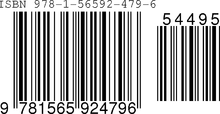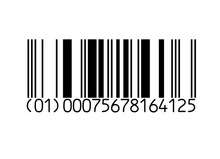Linear barcodes
Need to start using barcodes and don't know what to do? For more info visit the GS1 Czech Republic website.
Here is a list of the most used linear codes:
EAN (European Article Number)
 The most common EAN code and probably the most common barcode in general is EAN-13, which was defined by the GS1 Czech Republic standardization organization.
The most common EAN code and probably the most common barcode in general is EAN-13, which was defined by the GS1 Czech Republic standardization organization.
EAN-13 codes are used all over the world for marking different types of goods. The EAN-13 code can be used to identify, for example, the country of origin of the manufacturer or the use of the goods. Less used are EAN-8 codes, which are reserved and used for smaller items on which it is difficult to place a 13-digit code, such as confectionery.
EAN2
 This is an additional code to the EAN code - it is mainly used in the marking of publications to identify the issue number.
This is an additional code to the EAN code - it is mainly used in the marking of publications to identify the issue number.
EAN5
 An additional code to the EAN code - mainly used in the book industry to define the price of goods.
An additional code to the EAN code - mainly used in the book industry to define the price of goods.
CODABAR
 Also known as Codabar, Ames Code, NW-7, Monarch, Code 2 of 7, Rationalized Codabar, ANSI/AIM BC3-1995 or USD-4. It is designed to be easy to read when printed on dot matrix printers. It can also be printed sequentially on machines without the need for computer logic. After printing one part of the character/digit, the printer moves on to print the next part of the code. Nowadays, it is being replaced by newer symbologies that take up less space.
Also known as Codabar, Ames Code, NW-7, Monarch, Code 2 of 7, Rationalized Codabar, ANSI/AIM BC3-1995 or USD-4. It is designed to be easy to read when printed on dot matrix printers. It can also be printed sequentially on machines without the need for computer logic. After printing one part of the character/digit, the printer moves on to print the next part of the code. Nowadays, it is being replaced by newer symbologies that take up less space.
Code 128
 Code 128 is a one-dimensional code, the name suggests that it is capable of encoding 128 characters (the lower half of ASCII) - it is one of the few for characters that can distinguish and preserve case in the code. It has three character sets (A, B and C) which are set by one of the special characters at the beginning of the code and can be switched between during the code. Each Code 128 character consists of three lines and three spaces of a defined width, which is 1 to 4 times the atomic width (X). The code for each character is 11 X long, except for the last character (stop bits), which is 13 X long. The penultimate character is a checksum given by the sum of the multiples of each code (not ASCII but counted from 0) multiplied by its position, that integer modulo 103. This reduces the probability of an error to 1 in 5,000,000. If Code 128 is to carry a purely numeric code, it usually sets the character set to C and encodes the number in pairs of no.s, which can be more economical than some other barcodes that can only encode digits. Code 128 is used in logistics or to identify patents, for example.
Code 128 is a one-dimensional code, the name suggests that it is capable of encoding 128 characters (the lower half of ASCII) - it is one of the few for characters that can distinguish and preserve case in the code. It has three character sets (A, B and C) which are set by one of the special characters at the beginning of the code and can be switched between during the code. Each Code 128 character consists of three lines and three spaces of a defined width, which is 1 to 4 times the atomic width (X). The code for each character is 11 X long, except for the last character (stop bits), which is 13 X long. The penultimate character is a checksum given by the sum of the multiples of each code (not ASCII but counted from 0) multiplied by its position, that integer modulo 103. This reduces the probability of an error to 1 in 5,000,000. If Code 128 is to carry a purely numeric code, it usually sets the character set to C and encodes the number in pairs of no.s, which can be more economical than some other barcodes that can only encode digits. Code 128 is used in logistics or to identify patents, for example.
Code 39
The code is a variant of Code 128, it can encode 43 characters (A-Z uppercase letters only, digits the characters , -, ., $, /, +, %, and a space. The * character in the code serves as a separator. Unlike Code 128, Code 39 does not support checksums. It is also much longer than Code 128. Its advantage is that it can be printed using special fonts.
GS1-128
 Formerly also referred to as UCC/EAN-128, GS1 is a standardized code based on Code128. It allows multiple pieces of information (e.g., commodity code and serial number) to be stored in one code by separating the numbers called Application identifiers (numbers in brackets in the printed text) define what value will follow in the next part of the code.
Formerly also referred to as UCC/EAN-128, GS1 is a standardized code based on Code128. It allows multiple pieces of information (e.g., commodity code and serial number) to be stored in one code by separating the numbers called Application identifiers (numbers in brackets in the printed text) define what value will follow in the next part of the code.
GS1-Databar
 It is mainly used in commerce for traceability of goods. Its definition contains several subsets of codes, e.g. for multi-directional reading. Like GS1-128, it contains support for application identifiers.
It is mainly used in commerce for traceability of goods. Its definition contains several subsets of codes, e.g. for multi-directional reading. Like GS1-128, it contains support for application identifiers.
PHARMACODE
 It is used in the pharmaceutical industry to mark drug packages to identify the manufacturer of the package. The company that packages the drugs may not be the same as the manufacturer. The code is resistant to reading errors and can be printed in color combinations, and it is small so it takes up minimal space even on a small package.
It is used in the pharmaceutical industry to mark drug packages to identify the manufacturer of the package. The company that packages the drugs may not be the same as the manufacturer. The code is resistant to reading errors and can be printed in color combinations, and it is small so it takes up minimal space even on a small package.





